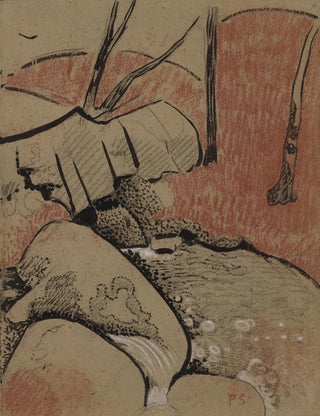Art print | Silver River at Huelgoat - Paul Sérusier


View from behind

Frame (optional)
Paul Sérusier’s captivating introduction to the art print Rivière d'Argent au Huelgoat
In the vibrant universe of art, certain works stand out for their ability to capture the essence of a moment, a place, or an emotion. "Rivière d'Argent au Huelgoat" by Paul Sérusier is one of those creations that transports the viewer into a landscape filled with mystery and serenity. This painting, created in 1898, evokes both the natural beauty of Brittany and the artistic genius of its author. Sérusier, an iconic figure of the Nabi movement, manages to transcend reality to offer a poetic and vibrant vision of his environment. The art print of this work invites immersion into a world where light and color intertwine to create an atmosphere that is both soothing and enchanting.
Style and uniqueness of the work
Sérusier’s style is characterized by an innovative approach to color and composition. In "Rivière d'Argent au Huelgoat," the choice of hues, ranging from silvery shades to flashes of green, creates a harmonious dialogue between natural elements. The river, winding through the landscape, becomes the guiding thread of this scene, while the trees and rocks, treated with simplified shapes and clear contours, evoke an almost dreamlike reality. The artist plays with light, which reflects on the water in a delicate and subtle manner, adding an almost spiritual dimension to the whole. This painting does not merely depict a landscape; it invites meditative contemplation, where each brushstroke seems to resonate with a deep intention.
The artist and his influence
Paul Sérusier, often considered one of the pioneers of post-impressionism, knew how to mark his era with his boldness and artistic vision. A student of Gauguin, he was influenced by the principles of synthesis and simplification of forms, while developing a personal style that is uniquely his own. The nabi movement, of which he was a part, advocated a spiritual and symbolic approach to art, seeking to express emotions rather than limiting itself to realistic representation. Sérusier also played a crucial role

Matte finish

View from behind

Frame (optional)
Paul Sérusier’s captivating introduction to the art print Rivière d'Argent au Huelgoat
In the vibrant universe of art, certain works stand out for their ability to capture the essence of a moment, a place, or an emotion. "Rivière d'Argent au Huelgoat" by Paul Sérusier is one of those creations that transports the viewer into a landscape filled with mystery and serenity. This painting, created in 1898, evokes both the natural beauty of Brittany and the artistic genius of its author. Sérusier, an iconic figure of the Nabi movement, manages to transcend reality to offer a poetic and vibrant vision of his environment. The art print of this work invites immersion into a world where light and color intertwine to create an atmosphere that is both soothing and enchanting.
Style and uniqueness of the work
Sérusier’s style is characterized by an innovative approach to color and composition. In "Rivière d'Argent au Huelgoat," the choice of hues, ranging from silvery shades to flashes of green, creates a harmonious dialogue between natural elements. The river, winding through the landscape, becomes the guiding thread of this scene, while the trees and rocks, treated with simplified shapes and clear contours, evoke an almost dreamlike reality. The artist plays with light, which reflects on the water in a delicate and subtle manner, adding an almost spiritual dimension to the whole. This painting does not merely depict a landscape; it invites meditative contemplation, where each brushstroke seems to resonate with a deep intention.
The artist and his influence
Paul Sérusier, often considered one of the pioneers of post-impressionism, knew how to mark his era with his boldness and artistic vision. A student of Gauguin, he was influenced by the principles of synthesis and simplification of forms, while developing a personal style that is uniquely his own. The nabi movement, of which he was a part, advocated a spiritual and symbolic approach to art, seeking to express emotions rather than limiting itself to realistic representation. Sérusier also played a crucial role






